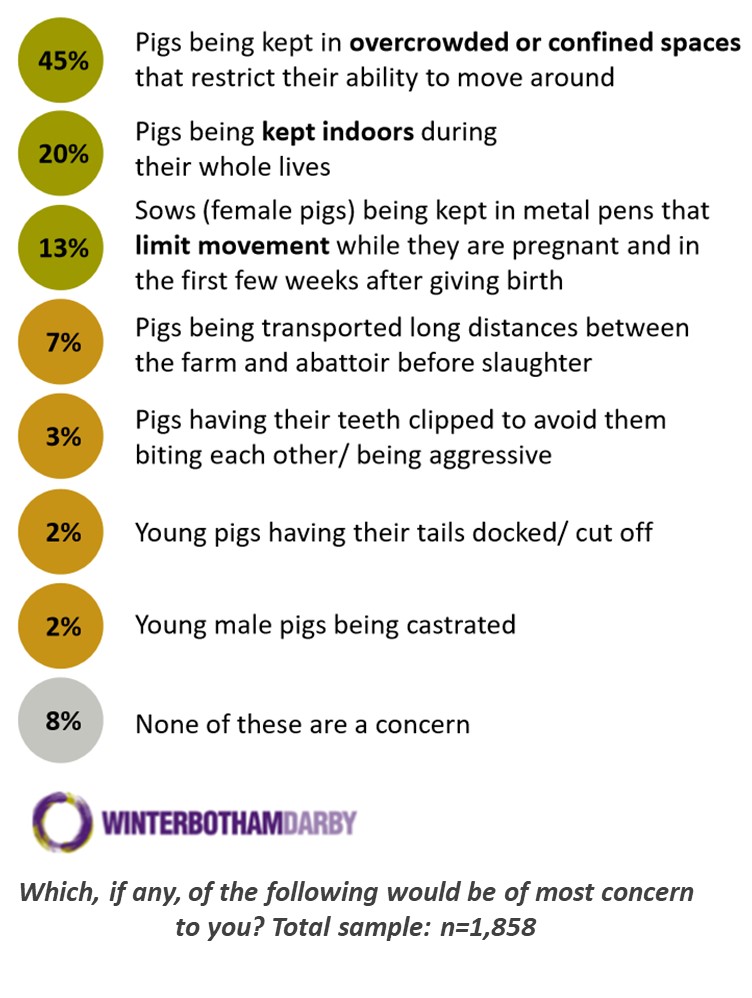



Animal Welfare: bringing consumer attitudes to the supply chain
Last week, the Winterbotham Darby Animal Welfare Media Round Table took place in London’s Covent Garden – a bustling agricultural trade centre in its past. The event brought together a number of industry representatives to discuss the progresses of swine welfare, from birth to slaughter, in the continental meat production industry.The discussion focussed on the welfare challenge for suppliers and retailers in the pig sector and the issue of labelling, and featured a presentation of new research into consumer attitudes. Representatives from leading farm animal welfare organisation, Compassion in World Farming (CIWF), also attended, with Elisa Bianco, European Food Business Manager, presenting CIWF findings on current developments in swine welfare.
Winterbotham Darby, a UK-based, welfare-award-winning supplier of continental meats, hosted the event in the hopes of progressing their primary animal welfare aims:
- To advance and progress animal welfare in continental meat production around Europe.
- To improve understanding in the food production industry and in consumers, of what is involved in high animal welfare – the costs and how it is achieved.
By closely connecting the whole supply chain, collaborating with welfare institutes, and reducing transport between each step of the production process, Winterbotham Darby advocates the ‘ring-fence’ approach, whereby multiple farms surround one central processing plant, reducing transport times and costs, therefore allowing more money to be spent on welfare measures. David Houghton, Technical Director, pointed out the work going into pain management strategies, new stunning techniques, and the breeding of ‘better mothers’ in sows to increase the usage of free-farrowing and group-housing on farms. He also highlighted the way in which the company uses ©Authenticate Information Systems to ensure complete transparency between producer and consumer regarding the supply chain.
With production sites across Europe, particularly areas where the legislation and funding for animal welfare in food production is not available, it is Winterbotham Darby’s hope that they can help shape the way in which welfare features in the continental meat supply chain – not only as an ethical concern, but also for the sustainability of businesses.
Consumers are becoming increasingly concerned with the origins of their food, the w ay it is produced, and, importantly, the standards of welfare along the production process. What is clear from the research provided by Phil Codling, Insight Director at OKO, however, is that an understanding of what puts some brands above others in terms of welfare standards, and how this is indicated in product labelling, remains a mystery to consumers.
ay it is produced, and, importantly, the standards of welfare along the production process. What is clear from the research provided by Phil Codling, Insight Director at OKO, however, is that an understanding of what puts some brands above others in terms of welfare standards, and how this is indicated in product labelling, remains a mystery to consumers.
A combination of online research, discussions with industry and academic contacts, interviews with consumers, and purchase diaries, indicated that welfare is a conscious thought on consumer’s minds as they are selecting products, but when it comes to the actual purchase, the focus is on quality, price and taste. This is contrary to the selection of other products, such as eggs and tuna, where consumers habitually choose brands with higher welfare promises and more sustainable origins.
It has been suggested that improved clarity of labelling is required to achieve association between different brands and welfare standards; the introduction of a distinguishable label that is nationally recognised and shows how a product of higher welfare is worth the premium. Three steps were suggested for achieving an effective welfare mark:
- Third Party endorsement.
- A simple visual cue.
- Testimonial and reasons for why consumers should refer to this label as assurance of its quality of welfare and low environmental impact.
It was pointed out that consumers commonly make the assumption that all products from the UK are automatically of higher welfare standards than imported produce – an idea far from the truth, and one that undermines the high standards of welfare that some farmers have worked hard to achieve. What was also clear from the responses of consumers when asked the question, “As far as you’re concerned, who is most responsible for animal welfare?”, is that the majority of people (72%) believe that farmers are most responsible for animal welfare in food production – not retailers, and not the government.
hard to achieve. What was also clear from the responses of consumers when asked the question, “As far as you’re concerned, who is most responsible for animal welfare?”, is that the majority of people (72%) believe that farmers are most responsible for animal welfare in food production – not retailers, and not the government.
This information essentially shows that it is time for government and retailers to step forward in creating positive changes for welfare labelling of produce, and educating consumers on the choices they can make. Not only to ensure that those advocating high welfare standards are rewarded for their commitment, but also to instil a level of traceability, transparency and trust between producers and consumers.
Elisa Bianco, CIWF, echoed these thoughts:
“It’s about increasing consumer awareness and legislation implementation, to promote and award progress in animal welfare standards.
“Animal welfare is not just the absence of negativity, but the presence of natural conditions, enrichment, and a good quality of life.”
Elisa made reference to some of the research presented by Winterbotham Darby, where consumers ranked the issues of pig welfare that they were most concerned about. Only 2% of consumers thought that male castration was of concern, and only 3% noted teeth-clipping. Elisa noted that it is clear that consumers do not understand the implications of using such practices – most people believe it is to stop aggressive behaviour that would naturally occur – but the reality is that these methods replace good management practice; enrichment and stimulation, and suitable feed rations, for example.
The European Food Business department of CIWF works hard to encourage and aid producers in improving their animal welfare; they do not name and shame those not achieving the desired standards, but instead, promote and reward businesses that are setting the bar. The ‘Good Pig’ Award does just this, and over the last two years, two of the Winterbotham Darby partnerships have earned this recognition.
Through close relationships with welfare organisations, it is hoped that producers can achieve low-cost, high-value solutions within their management practice that can allow them to reach the highest standards of animal welfare.
For more information on progressing pig management, click here
For more information on the progression of welfare with Winterbotham Darby, click here









